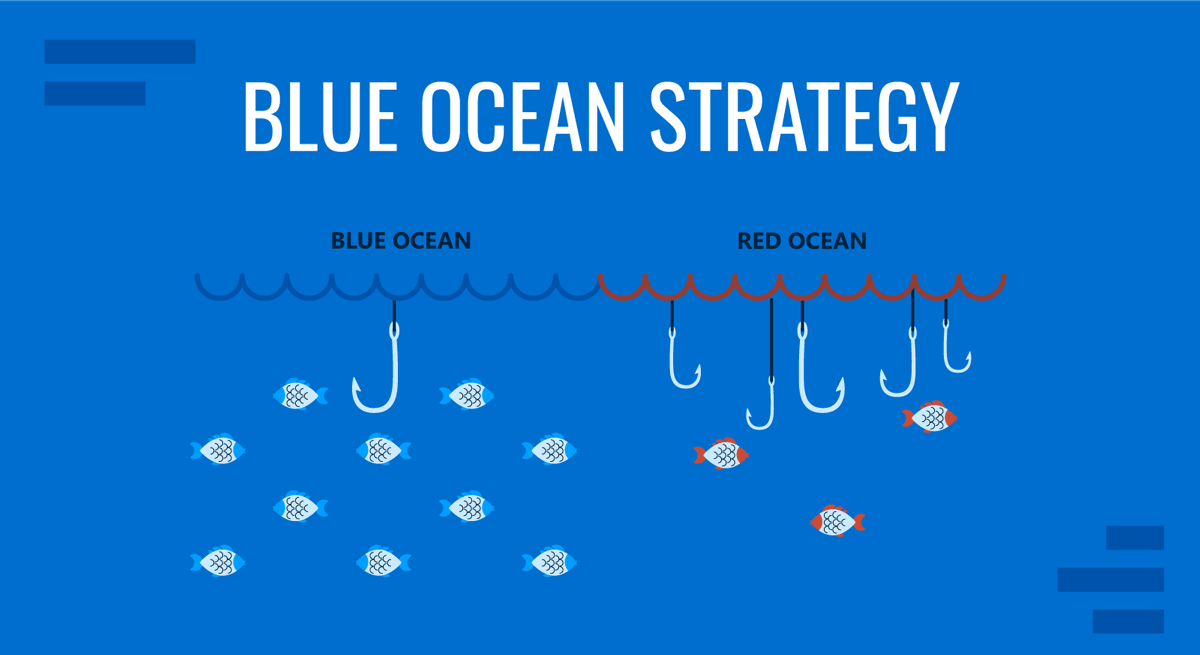
The Blue Ocean Strategy is a framework and set of business growth and innovation tools. This easy-to-understand article will guide you through the principles of the strategic approach, showing how it differs from the more traditional competitive strategy thinking. We’ll look at how it affects business results, changes the way managers think, see how it’s used in different industries, and aligned with our expertise, we will showcase how to present the analysis tools results to an executive audience.
Table of Contents
- Introduction
- Blue Ocean Strategy vs. Red Ocean Strategy
- Implementing Blue Ocean Strategy
- Tools to Complement Blue Ocean Strategy Analysis
- Impact and Influence of Blue Ocean Strategy
- FAQs
- Conclusion
Introduction
What is Blue Ocean Strategy
The Blue Ocean Strategy is a unique approach to business growth that encourages companies to create new market spaces instead of competing in saturated markets. This strategy suggests that success can be found in ‘blue oceans’ – untapped, uncontested market spaces ripe for growth. The strategy emphasizes the simultaneous pursuit of differentiation and low cost to open up a new market space and create new demand. It is about creating and capturing uncontested market space, making the competition irrelevant.
Origin and Development of Blue Ocean Strategy
The Blue Ocean Strategy emerged from the groundbreaking work of W. Chan Kim and Renée Mauborgne. In 2005, they introduced this revolutionary concept in their best-selling book, “Blue Ocean Strategy: How to Create Uncontested Market Space and Make the Competition Irrelevant“. The framework was successfully applied in several industries, proving an effective new way of creating competitive strategies.
Key Concepts and Principles of Blue Ocean Strategy
Blue Ocean Strategy pivots on two main principles: value innovation and the creation of uncontested market space. Value innovation involves delivering superior value to customers through differentiation and low cost. It’s not about beating the competition but making it irrelevant by redefining the industry boundaries. The strategy also emphasizes the creation of uncontested market space, or ‘blue oceans,’ rather than competing in existing ‘red oceans.’ This is achieved by expanding existing industry boundaries or creating entirely new industries. These principles guide businesses to break away from the competition and achieve sustainable growth.
Blue Ocean Strategy vs. Red Ocean Strategy
Differences Between Blue Ocean and Red Ocean Strategies
Red Ocean Strategy competes in existing market space; Blue Ocean Strategy creates uncontested market space.
Advantages and Disadvantages of Blue Ocean Strategy
The Blue Ocean Strategy offers significant advantages, including creating new market space, reduced competition, and increased profit potential. However, it also presents challenges such as a high risk of failure, significant resource investment, and the uncertainty of unexplored markets. It’s crucial to weigh these factors when considering this approach.
Examples of Blue Ocean Strategy in Practice
A compelling instance of the Blue Ocean Strategy in the pharmaceutical industry is Novo Nordisk’s introduction of Ozempic. Novo Nordisk, a global healthcare company, recognized the unmet need for a more effective, once-weekly treatment for type 2 diabetes. They created Ozempic, a novel product that significantly improved glycemic control and weight loss. Unlike traditional strategies focused on fierce competition, Novo Nordisk ventured into a ‘blue ocean’ of uncontested market space. They differentiated Ozempic from existing treatments, delivering unique value to patients and healthcare providers. This innovative approach allowed them to capture new demand, creating a win-win situation for the company and its customers. Novo Nordisk’s success with Ozempic exemplifies the power of the Blue Ocean Strategy in transforming industry boundaries and reshaping market dynamics.
Implementing Blue Ocean Strategy
Tools and Frameworks for Blue Ocean Strategy
Several tools can be used to perform a Blue Ocean Strategy Analysis. The Strategy Canvas (also known as Value Curve) is a diagnostic tool that visually represents a company’s current strategic position in the existing market space. It helps businesses identify factors the industry competes on and invests in and what customers receive from the existing competitive offerings.
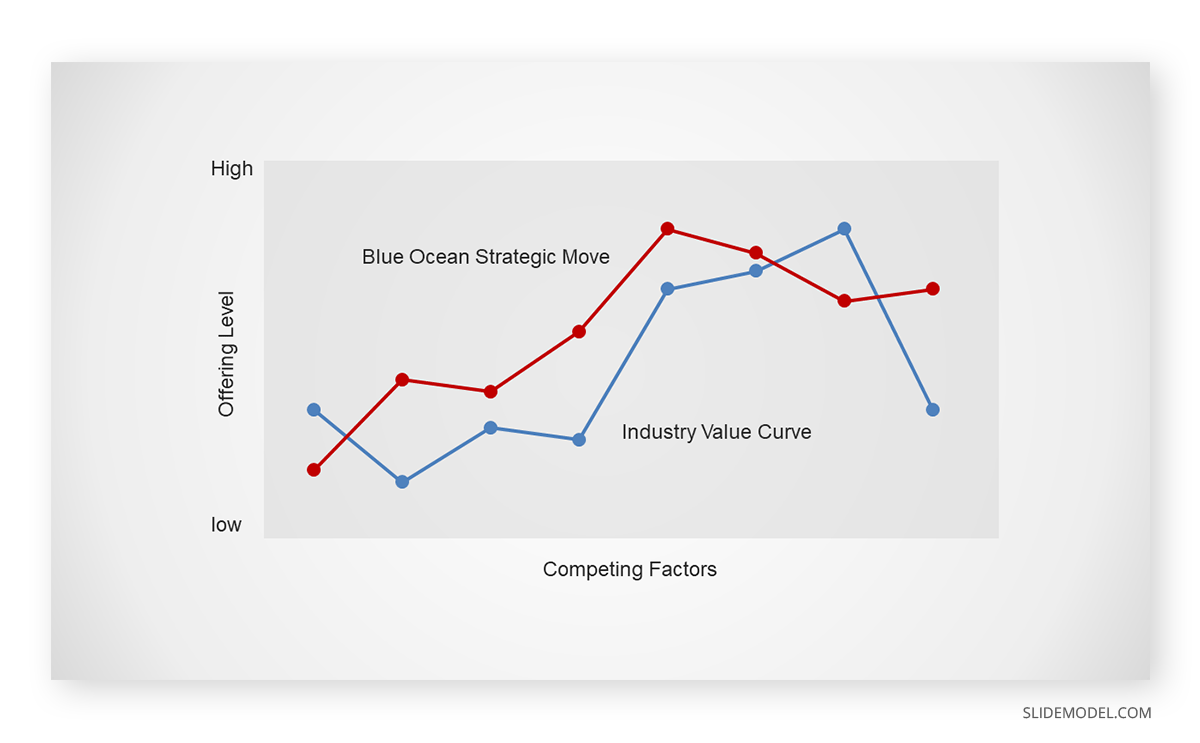
The Four Actions Framework assists businesses in breaking the trade-off between differentiation and low cost. It challenges companies to simultaneously pursue both by asking four key questions: which factors should be eliminated, reduced, raised, and created? On the other hand, the Eliminate-Reduce-Raise-Create (ERRC) Grid complements the Four Actions Framework by compelling companies to act on all four to create a new value curve. It pushes businesses to decide what factors to eliminate, reduce, raise, and create that the industry has never offered.
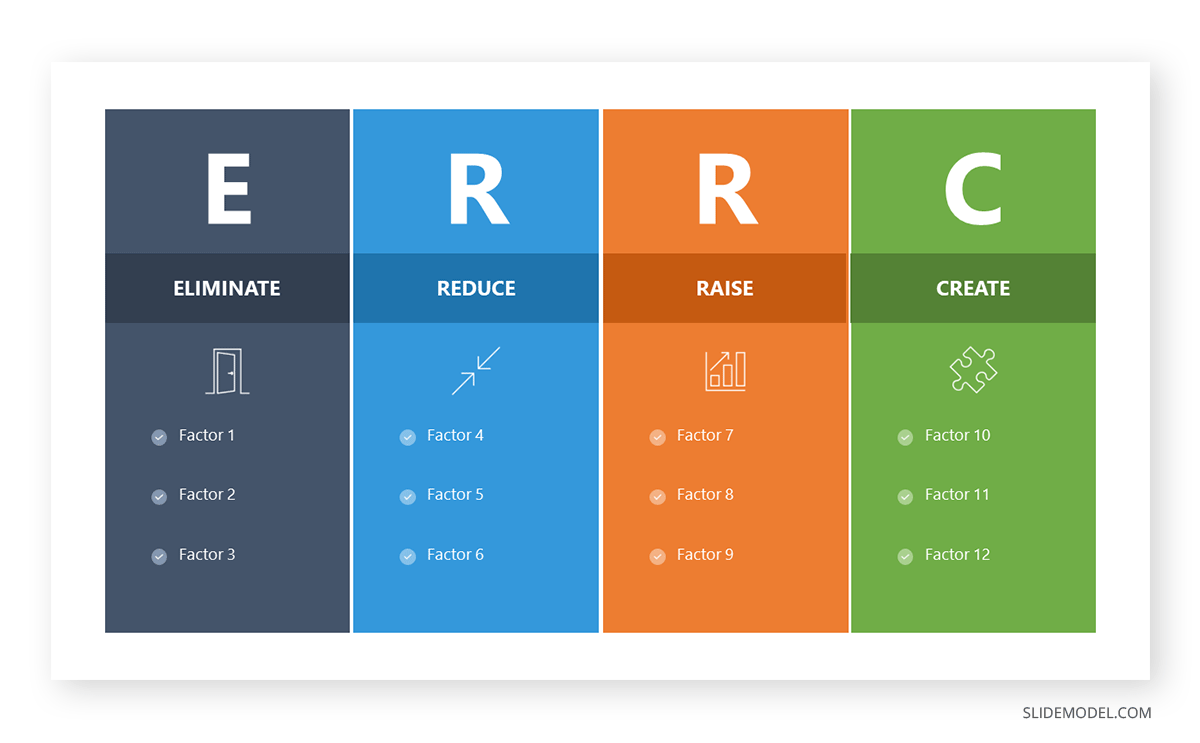
The Buyer Utility Map is another instrumental tool in the Blue Ocean Strategy. It enables businesses to identify utility spaces in a buyer’s experience to create a blue ocean market space. The map includes a buyer’s experience cycle and six utility levers – purchase, delivery, use, supplements, maintenance, and disposal. By assessing the buyer’s experience across these utility levers, businesses can pinpoint where to eliminate, reduce, raise, or create a new utility to break away from the competition.
The Price Corridor of the Mass is a tool that helps businesses pinpoint the price level within the mass of target buyers. This tool has two steps. First, it identifies the price corridor of the mass by looking at the price sensitivity of the different mass of buyers. Then, it specifies a level within the price corridor by examining the extent to which the new offering’s price can be affected by the streamlining of operations.
These tools, when combined, can help a company break away from the competition and create a blue ocean of uncontested market space. You can find this wide range of tools in our Blue Ocean Strategy PowerPoint template.
Steps to Implement Blue Ocean Strategy
In the shoes of a Consultant:
Step 1: Begin with the Strategy Canvas
List the top 5 competitors in the industry, list the top 10 attributes you can understand and evaluate from the target market, and create the value curve around these variables. Gather real-life information from the target market and iterate over the value curve.
Step 2: Utilize the Four Actions Framework
Based on the Value curve attributes analyzed, Identify which factors to eliminate, reduce, raise, or create to outrank the competition, achieving more “perceived” value.
Step 3: Apply the Eliminate-Reduce-Raise-Create Grid
Act on all four actions identified in the previous step, breaking the trade-off between differentiation and low cost.
Step 4: Construct a Buyer Utility Map
To understand how to create a leap in buyer value, you must understand the buyer’s journey and perceived value in each step.
Step 5: Determine the Price Corridor of the Mass
Using this tool, you need to set the right price for the newly created blue ocean You have to gauge current competition and substitutes to understand the current pricing mindset in the target market. If there is still no competition, define the price with a bottom on operating costs + profit and set a ceiling with the cost of a possible customer not solving the issue with the product/service you are offering.
Step 6: Test the Strategy
Finally, use the Business Model Canvas to apply the strategy to the business model and analyze how to test it out of the building.
How To Present the Analysis Made with Blue Ocean Strategy Tools in a PowerPoint Presentation
Presenting the outcome of a Blue Ocean Strategy consultancy to a board of directors involves showcasing eight critical slides.
The first slide should introduce the Blue Ocean Strategy concept, emphasizing its focus on creating uncontested market space, making competition irrelevant.
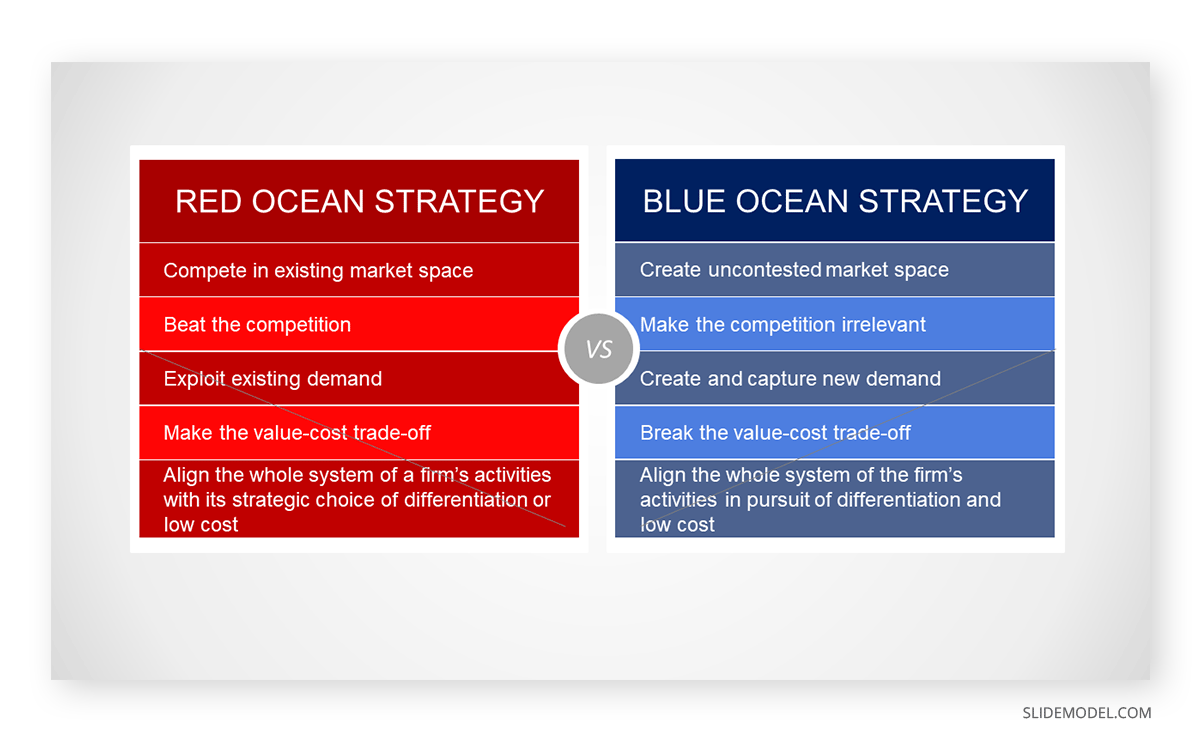
The second slide should present an overview of the company’s current competitive landscape, identifying the red ocean in which it operates.
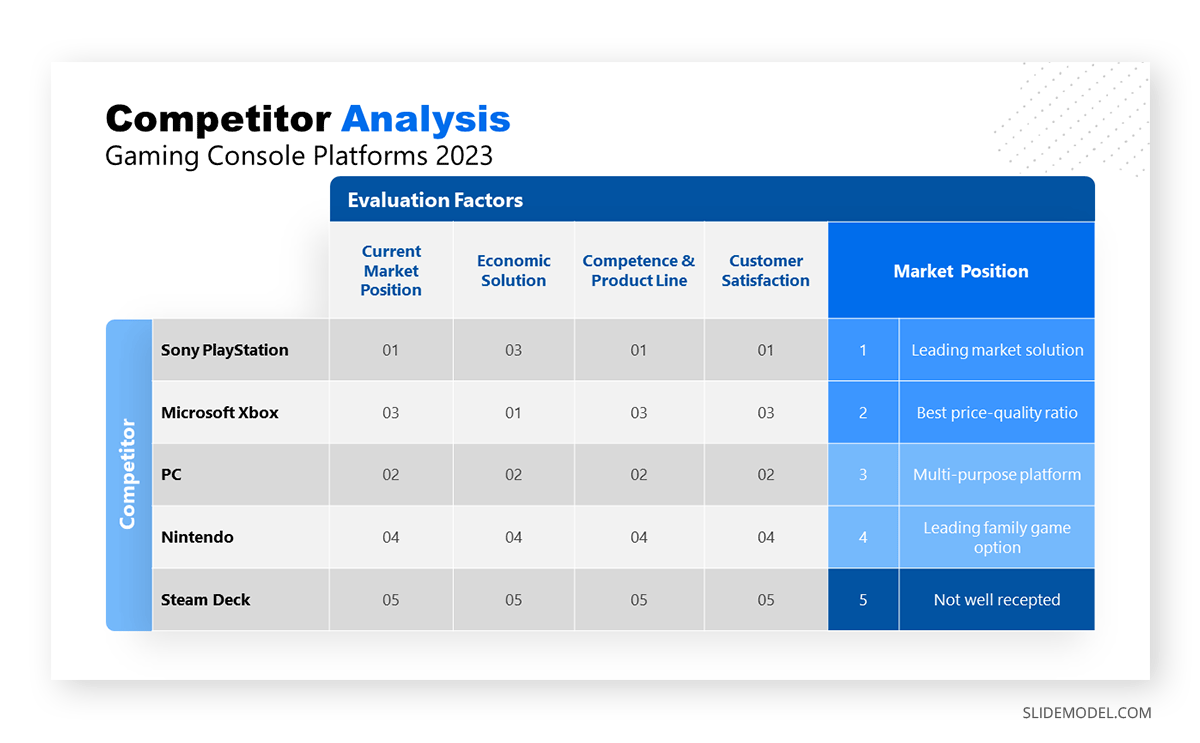
The third slide should showcase the Strategy Canvas (Value Curve).
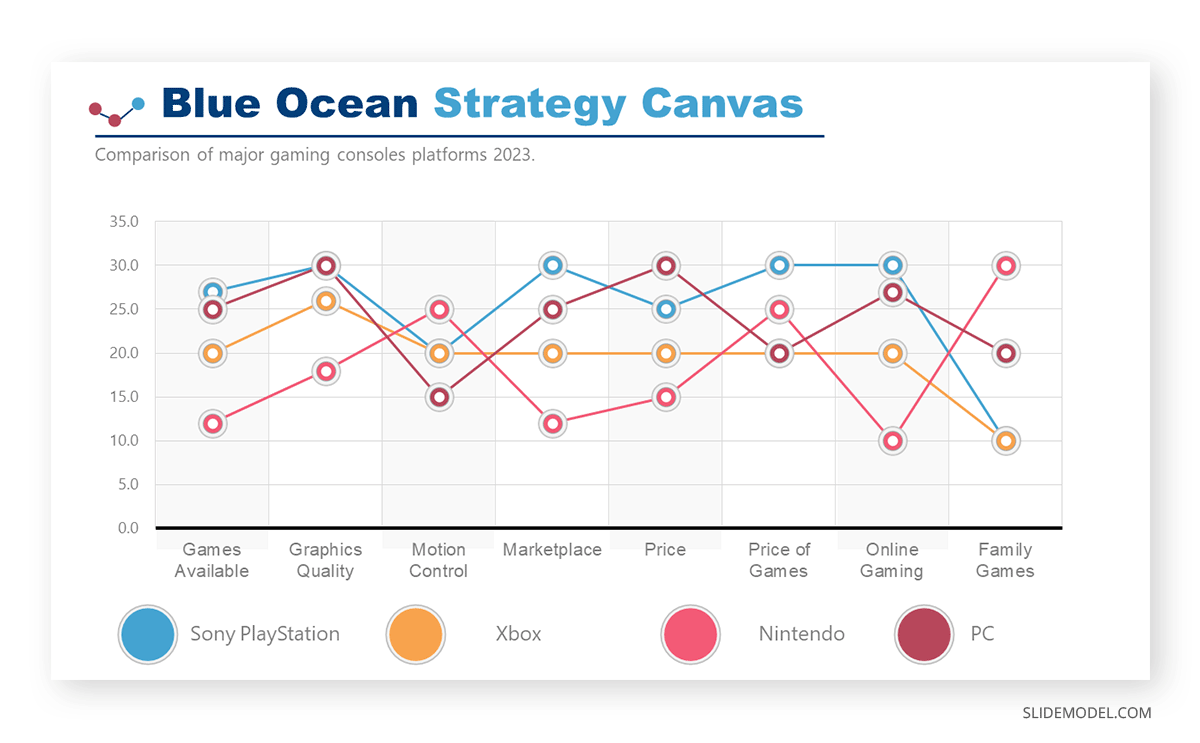
The fourth slide should introduce the Four Actions Framework and show the ERRC matrix, indicating the studied factors the company can eliminate, reduce, raise, and create and which actions should be taken to act on them.
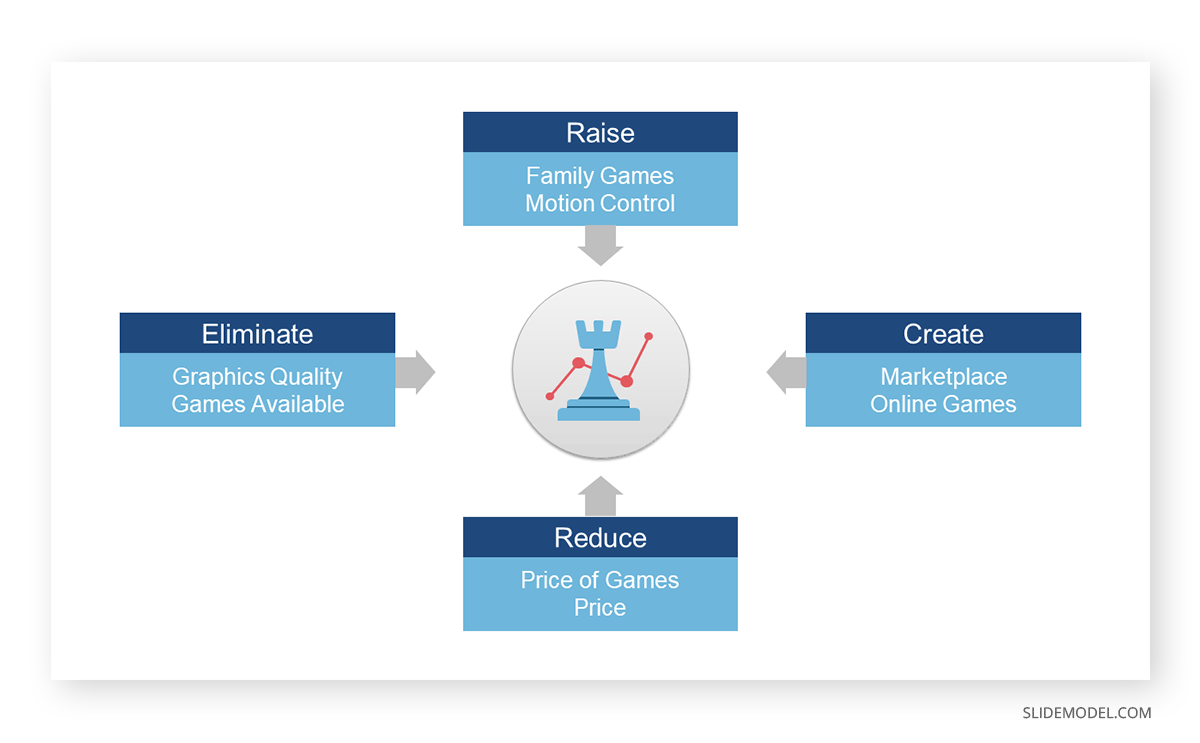
The fifth slide should detail the company’s new value proposition, demonstrating how it can meet customers’ needs uniquely and cost-effectively.
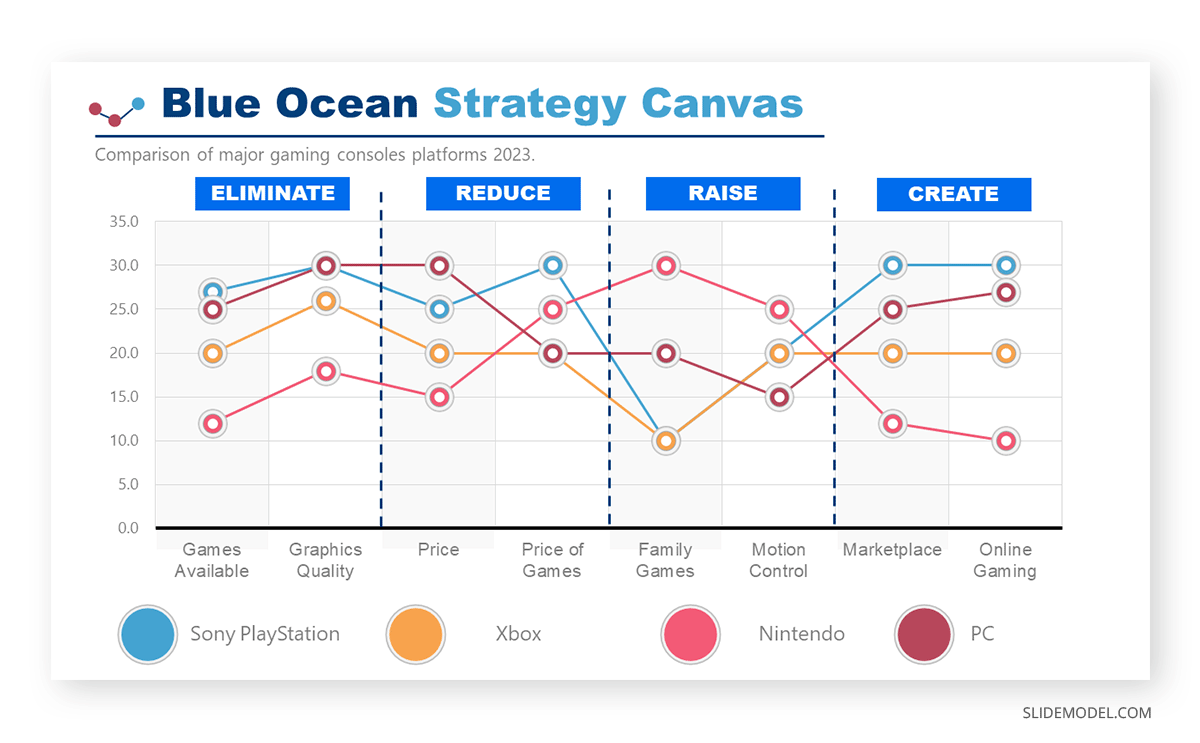
The sixth slide should illustrate the company’s potential blue ocean, using the Buyer Utility Map to show how the new offering will unlock exceptional utility for customers.
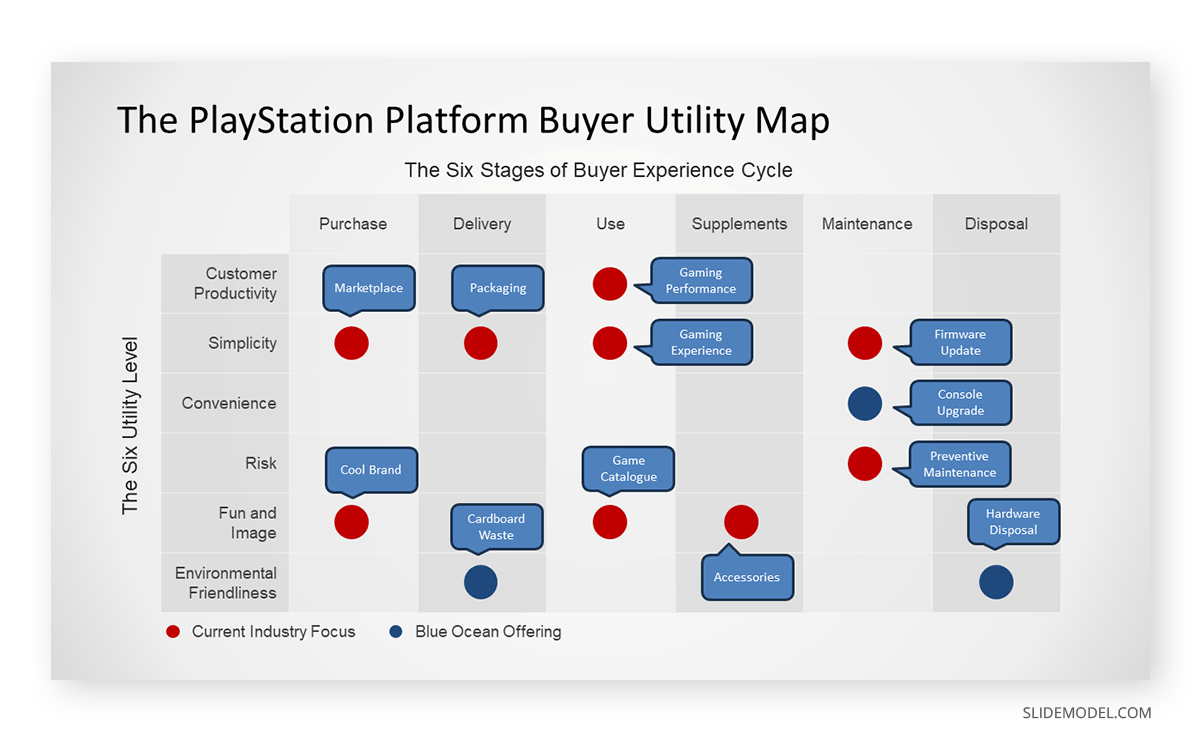
The final slide should summarize the projected impact of implementing the Blue Ocean Strategy on the company’s growth, profitability, and competitive positioning. Each slide should be concise yet comprehensive, persuasively communicating the transformative potential of the Blue Ocean Strategy.
Challenges and Risks in Implementing Blue Ocean Strategy
The Blue Ocean Strategy is not a panacea for all business strategy issues, so we highly advice taking these potential challenges and risks of its implementation into account:
- The design can be resource-intensive.
- There is a risk of misjudging the market demand, leading to potential financial losses.
- Companies may face internal resistance when shifting from traditional strategies to innovative approaches.
- While the Blue Ocean Strategy encourages differentiation, it is possible to diverge too drastically from the company’s core competencies, leading to operational difficulties.
Tools to Complement Blue Ocean Strategy Analysis
The Blue Ocean Strategy (BOS) is undeniably powerful in pursuing uncontested market spaces. Yet, like any strategy, it is not a standalone solution. Utilizing complementary tools to enhance its effectiveness and ensure comprehensive strategic planning is crucial. One such tool is the SWOT analysis, an acronym for Strengths, Weaknesses, Opportunities, and Threats. It provides a clear picture of the organization’s internal and external environment, essential in identifying potential blue oceans. The strengths and weaknesses part of the analysis help determine the company’s current capabilities and gaps, while the opportunities and threats part aids in recognizing potential blue oceans and red oceans.
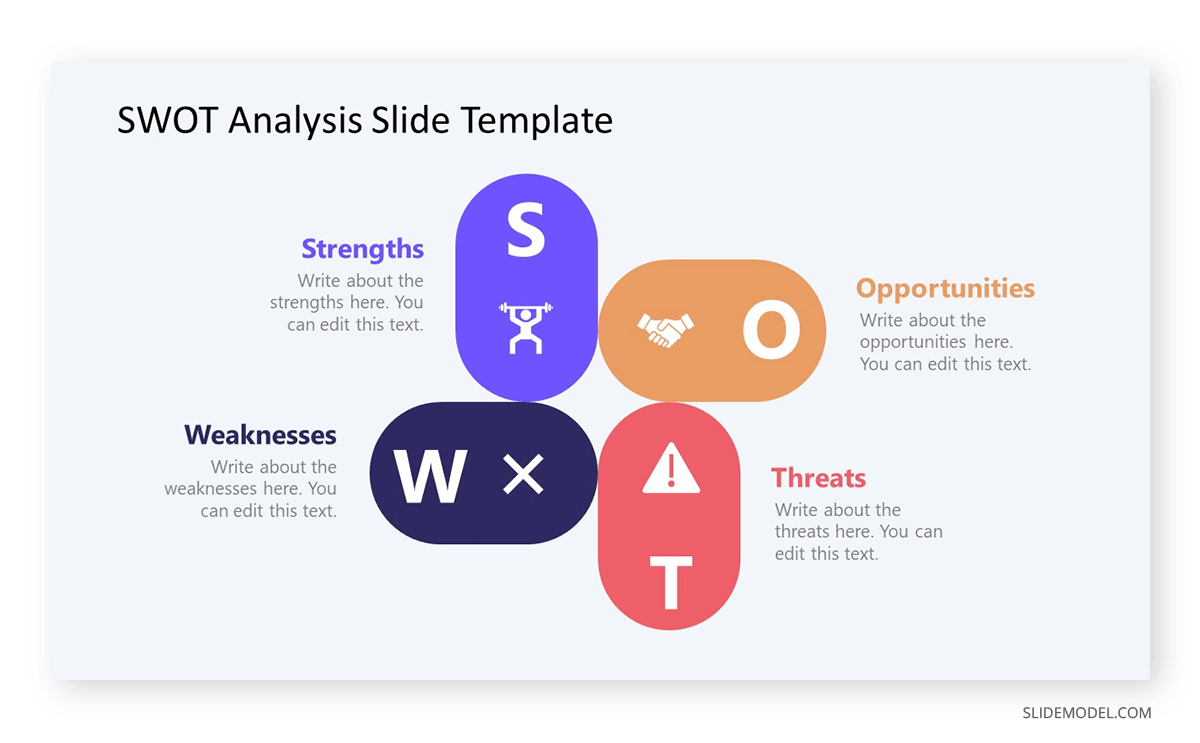
Download Free SWOT Analysis Template
Another complementary tool is the Balanced Scorecard. This tool helps execute the BOS by aligning the organization’s vision and strategy with its activities. It measures performance from four perspectives: financial, customer, internal processes, and learning and growth. Doing so ensures that the organization does not lose sight of its strategic goals while pursuing a blue ocean.
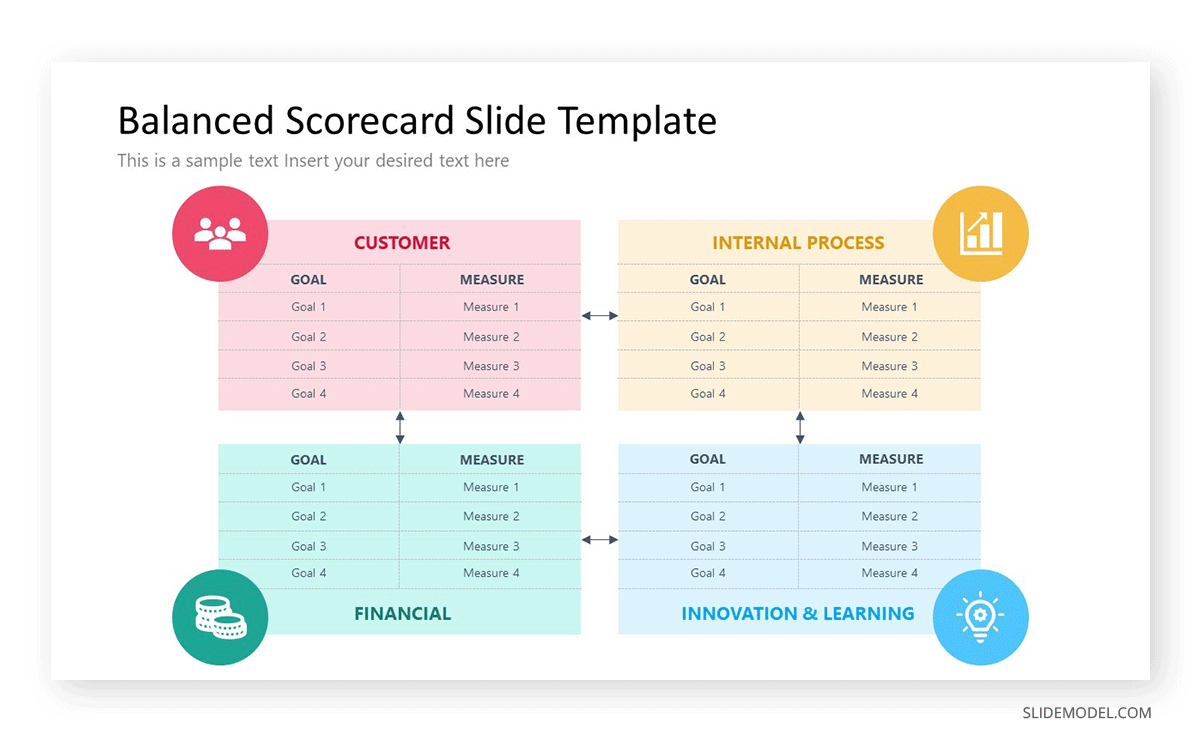
Download Free Balanced Scorecard Template
Porter’s Five Forces is also a valuable tool to complement BOS. It helps organizations understand the competitive forces in their industry and how they can manipulate them in their favor. This understanding is crucial in creating a blue ocean where competition is irrelevant.

Download Porter Five Forces PowerPoint Template
Lastly, the Value Innovation tool can enhance the effectiveness of BOS. It encourages organizations to innovate to deliver exceptional customer value, thus creating a blue ocean.
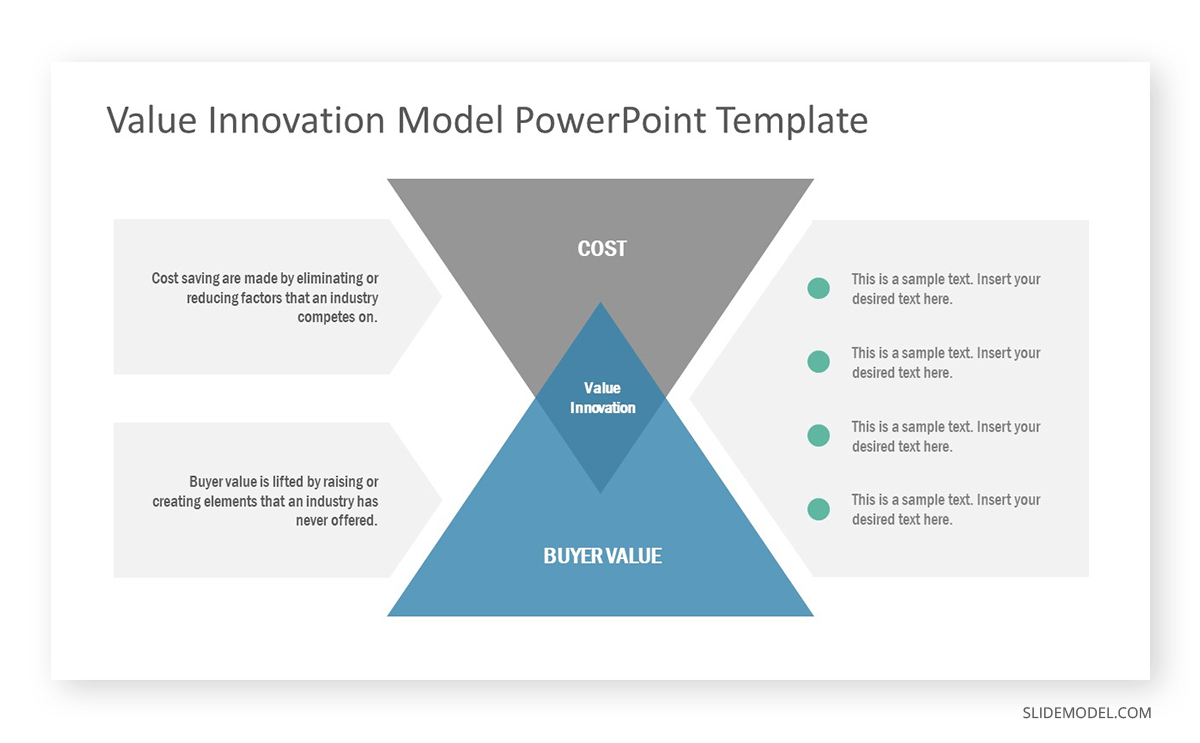
Download Value Innovation Model PowerPoint Template
In conclusion, while the Blue Ocean Strategy is a powerful tool in strategic planning, its effectiveness can be significantly enhanced using complementary tools. These tools not only aid in identifying and creating blue oceans but also in executing and sustaining the strategy.
Impact and Influence of Blue Ocean Strategy
Impact on Business Performance and Growth
By creating uncontested market space, companies can avoid the fierce competition of saturated markets, improving profit margins. The innovative approach encourages sustainable growth by continually exploring new opportunities. Businesses employing this strategy often witness increased customer loyalty and brand recognition, further driving their financial performance. Hence, the Blue Ocean Strategy can be a powerful tool for businesses seeking substantial growth and improved performance.
Influence on Business Strategy and Management Thinking
It disrupts traditional competitive models, advocating for value innovation and untapped market spaces. This strategy encourages businesses to shift their focus from competition to creation, fostering a mindset of abundance rather than scarcity. It has revolutionized management thinking by challenging the status quo and promoting a culture of innovation and strategic differentiation. Consequently, many firms have adopted this strategy, transforming their approach to business and achieving remarkable success.
Criticisms and Controversies Surrounding Blue Ocean Strategy
Blue Ocean Strategy, despite its popularity, has faced substantial criticism. Skeptics argue that it oversimplifies the complexity of strategy development and execution. They claim it promotes unrealistic expectations of competition-free environments, disregarding the inevitability of competition in business. Critics also question the strategy’s applicability across industries, suggesting it may only work for certain types of businesses. Furthermore, the strategy’s focus on innovation is seen as potentially risky, as not all innovations guarantee success. These controversies fuel ongoing debates in the business strategy field.
FAQs
How does the Blue Ocean Strategy differ from traditional business strategies?
Whereas traditional business strategies opt to focus on competing in existing markets, creating a potential advantage to outperform their competitors (i.e., creative ideas, pricing, marketing strategy, influencers, etc.), the Blue Ocean Strategy focuses on creating new markets. This approach has the driving force of delivering value to customers, which in turn renders the competition factor irrelevant.
How can a company create a “blue ocean”?
Start by identifying unmet customer needs, new business models, or unexploited technologies, then focus on answering how can your company deliver a unique value to customers over those variables.
How can a company sustain its blue ocean over time?
By implementing continuous innovation processes, which also stay attuned to trend changes in customer needs.
What is the ERRC grid in the Blue Ocean Strategy?
The Eliminate Reduce Raise Create grid is a strategic planning tool that helps companies create new market spaces and establish differences from competitors. Here’s how each component of the acronym can be defined:
- Eliminate: Identify which factors or features the industry the company moves in are taken for granted, but by eliminating them, we can reduce costs and simplify the offer.
- Reduce: Pinpoint which factors or features can be reduced below industry standard values. This measure is taken to further reduce costs.
- Raise: Recognize which factors or features can be raised above the industry standards. By taking this action, we can increase our value offering for customers.
- Create: Open up new market spaces by creating factors or features the industry has never offered.
Can the Blue Ocean Strategy be applied to small businesses or startups?
Yes, this framework can be applied to all business sizes, and smaller companies can have a smoother experience implementing the Blue Ocean Strategy due to the ease of innovating and accelerating processes compared to large corporations.
Conclusion
Our exploration of the Blue Ocean Strategy uncovered its transformative power in business. This innovative approach, which encourages companies to create uncontested market spaces rather than compete in an overcrowded marketplace, has undeniably changed the landscape of strategic planning and execution.
The Blue Ocean Strategy is not merely a theoretical concept but a practical tool successfully used by numerous companies across various industries. Its effectiveness lies in its ability to create value innovation, where companies can simultaneously pursue differentiation and low cost, thereby making the competition irrelevant. However, it’s crucial to acknowledge that the Blue Ocean Strategy is not a one-size-fits-all solution. Its implementation requires careful planning, strategic thinking, and a deep understanding of the market and customers. It also poses challenges and risks, such as the possibility of imitation by competitors and the uncertainty of venturing into unexplored markets.
Despite these challenges, the advantages of the Blue Ocean Strategy far outweigh its potential drawbacks. It provides a roadmap for companies to escape the bloody competition of red oceans and create their blue oceans of uncontested market space. It has the potential to drive business growth, enhance competitiveness, and foster innovation. Critics may argue about its feasibility and applicability, but there’s no denying its impact on business strategy and management thinking. The Blue Ocean Strategy has challenged traditional strategic models and inspired a new wave of strategic thinking emphasizing value creation and innovation.
In conclusion, the Blue Ocean Strategy is a powerful tool that can redefine the way businesses compete and operate. It is a testament to the power of innovation and strategic thinking in shaping the future of businesses and industries. The Blue Ocean Strategy offers hope as we move forward in an increasingly competitive and volatile business environment, guiding companies towards uncharted waters of opportunity and growth.


